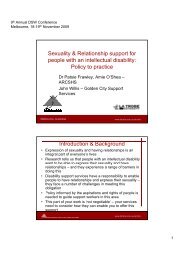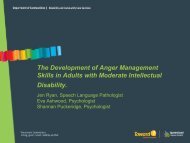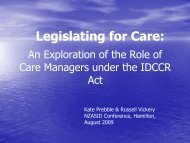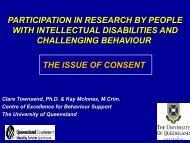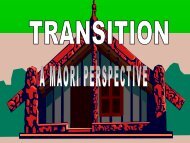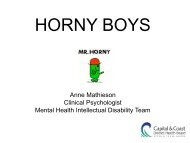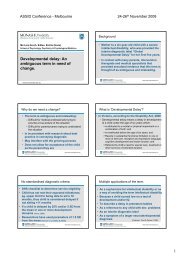Heidegger, Dasein and Disability - Australasian Society for ...
Heidegger, Dasein and Disability - Australasian Society for ...
Heidegger, Dasein and Disability - Australasian Society for ...
You also want an ePaper? Increase the reach of your titles
YUMPU automatically turns print PDFs into web optimized ePapers that Google loves.
<strong>Heidegger</strong>, <strong>Dasein</strong> <strong>and</strong> <strong>Disability</strong>: Re-thinking what itmeans to be Human?Terri FealyLa Trobe UniversityContact Email: tfealy@students.latrobe.edu.au
whether his philosophy will provide a more inclusive picture <strong>for</strong> people withdisability.My focus on <strong>Heidegger</strong> will begin with a close reading of Being <strong>and</strong> Time in terms ofhis inquiry into <strong>Dasein</strong> <strong>and</strong> the ‘meaning of being’. I am particularly interested as towhether his inquiry can be inclusive of those people with profound intellectualdisability. Despite the fact that <strong>Heidegger</strong> sets a different question <strong>and</strong> undertakes adifferent approach to traditional western philosophy, is <strong>Heidegger</strong>’s existentialanalytic of <strong>Dasein</strong> limited to those human entities that are intellectually competent,rational <strong>and</strong> capable of an economic contribution to society? Can his enquiry offeranything more inclusive <strong>for</strong> people with disability than his predecessors?I will consider the above questions with particular emphasis on <strong>Heidegger</strong>’s notion of<strong>Dasein</strong> as ‘being-in-the-world’ <strong>and</strong> as ‘being-with’. As it is not possible to considerevery aspect of <strong>Heidegger</strong>’s thought in relation to the inclusion of people withdisability, I have decided to focus on that aspect of <strong>Dasein</strong> which is in relation withothers. As people with disability experience exclusion, as exclusion from being-with,it seems that this idea of <strong>Heidegger</strong>’s offers an interesting avenue into his philosophy<strong>for</strong> considering the place of people with disability.As an aside I want to briefly set the scene regarding the dominant view of how peoplewith disability are seen within contemporary society. In the past the plight of peoplewith disability <strong>and</strong> the issues associated with ‘being disabled’ were largely confinedto the private domain. In recent history this has changed. <strong>Disability</strong> occupies a spacein the public domain in terms of the political <strong>and</strong> social. Additionally, disability isnow an area of academic enquiry <strong>and</strong> study, as well as there being professionaltraining courses <strong>for</strong> those working in the field. People with disability themselves, arefar more apparent in contemporary society than they were in the past. Despite the factthat disability is now at a level of societal <strong>and</strong> political consciousness, there is stillsignificant stigma associated with being disabled, <strong>and</strong> many debates about how best toaddress the ‘problem’ of disability.In early 2003 Christopher Reeve, a high profile actor <strong>and</strong> quadriplegic, came toAustralia by invitation from Bob Carr to attend a <strong>for</strong>um on spinal cord injury, <strong>and</strong> toPage 3 of 17 04/07/2008
join in the debate on stem cell research. Whilst <strong>for</strong> most Australians this debate raisesquestions of morality in relation to making use of embryonic stem cells, the debate isquite a different one <strong>for</strong> many within the disability community 2 . The obsessive questto find a ‘cure’ that was represented by Christopher Reeve created a great deal ofanger <strong>for</strong> those in the disability field that are part of a movement aimed at trying tocreate a greater acceptance <strong>and</strong> underst<strong>and</strong>ing of disability as simply being part of thespectrum of what it means to be a human person. Christopher Reeve represents a viewthat disability is an un<strong>for</strong>tunate accident, sickness or anomaly that needs to be fixed orcured. The arguments opposing this view, recognise that disability is not only one ofthe ways in which human beings exist, but is, in fact, no less desirable <strong>and</strong> of no lessvalue than any other expression of being human.The debates initiated by Christopher Reeve’s visit to Australia, continue to dividethose with disability <strong>and</strong> those involved with them. My reason <strong>for</strong> raising this debateis that it raises a problem regarding the approach taken to dealing with disability. Thedisability debates revolve around what it means to be human <strong>and</strong> what are the limitsof being human. That is, at what point do we say that a certain life is no longeracceptably or desirably human. When people argue <strong>for</strong> withdrawal of medicalintervention, the arguments are often associated with the capacity of the person. Werefer to people with profound intellectual disability or brain damage as people beingin a vegetative state. The use of the word ‘vegetative’ should not be underestimated.The use of a term that compares the person to a non-human state is very powerful.And the implications are not lost. Such a referent leaves hanging the view that such aperson is not really human. The approach also reveals that the way we underst<strong>and</strong>what it means to be human is related to our capacities <strong>and</strong> our characteristics. Theimplication of this <strong>for</strong> people with a disability is that they end up being understood interms of their deficits. It seems to me that this approach to underst<strong>and</strong>ing what it is tobe a human being, sets an acceptable minimum st<strong>and</strong>ard <strong>and</strong> anything that falls belowthat st<strong>and</strong>ard is not acceptable.So what does all of this have to do with <strong>Heidegger</strong> <strong>and</strong> his quest into the meaning ofbeing? The relevance is that <strong>Heidegger</strong> also recognises that traditional philosophy hasbeen focused on questions that leave out the most primary question of all. What does2 See <strong>for</strong> example (Leipoldt et al., 2003)Page 4 of 17 04/07/2008
it mean ‘to be’? Whilst western philosophy has been concerned with the entity of thehuman person, it has done so in terms of trying to underst<strong>and</strong> ‘what’ a human personis. <strong>Heidegger</strong> is insistent that there is a more primary question that philosophy needsto consider <strong>and</strong> that is, what does it mean to be this entity we name a human person.As I personally hold the view that people with disability are simply part of thespectrum of what it means to be human, I am keen to find a starting point whichacknowledges this. Such a starting point then sets a completely different agenda <strong>for</strong>how we address what it means to have a disability, <strong>and</strong> the consequent ways in whichpeople with disability are regarded in society.In inquiring into the question of being, <strong>Heidegger</strong> is not inquiring into the ‘what’ ofan entity. He is critical of the idea that there is a subject who st<strong>and</strong>s apart from anobject to be identified in terms of properties <strong>and</strong> characteristics that define it. Inmoving away from the idea “of the human being as an unmoving point of view uponthe world” (Mulhall, 1996:39), <strong>Heidegger</strong> underst<strong>and</strong>s that we are actors in theinquiry. If the inquirer is also an actor, then the method of inquiry must recognise this.<strong>Heidegger</strong> described this method as phenomenology, an “…analysis by which themeaning of various ways in which we exist can be translated from the vague languageof everyday existence into the underst<strong>and</strong>able <strong>and</strong> explicit language of ontologywithout destroying the way in which these meanings manifest themselves to us in oureveryday lives” (Gelven, 1989:42. Italics in original) By asking what it means ‘to be’rather than ‘what is’ a human being, <strong>Heidegger</strong> has thrown the philosophical traditionon it’s head.Furthermore, <strong>Heidegger</strong> insists that we must take account of our preconceptions. Theinquiry must be transparent to itself. So whilst ‘Being’ refers not only to humans, butalso to animals, nature <strong>and</strong> objects, “…the meaning of being must be sought in humanunderst<strong>and</strong>ing” (Frede, 1993:50). Just as <strong>Heidegger</strong> distinguishes his inquiry from thatof science which investigates a material entity, he also distinguishes that entity whichis the human being from other entities <strong>and</strong> makes this the centre of his inquiry. It isimportant to underst<strong>and</strong> the difference between inquiring about an ‘entity’ <strong>and</strong> what itmeans ‘to be’.Page 5 of 17 04/07/2008
To assist in making clear the difference <strong>Heidegger</strong> uses the term <strong>Dasein</strong>, whichliterally means ‘being there’. Unlike scientists <strong>and</strong> previous philosophers whoinquired into the properties <strong>and</strong> characteristics of the human person, <strong>Dasein</strong> is thatentity <strong>for</strong> which the ‘meaning of being’ is a concern <strong>for</strong> it.<strong>Dasein</strong> is an entity which does not just occur among other entities. Rather it isontically distinguished by the fact that, in its very Being, that Being is an issue <strong>for</strong>it. But in that case, this is a constitutive state of <strong>Dasein</strong>'s Being, <strong>and</strong> this impliesthat <strong>Dasein</strong>, in its Being, has a relationship towards that Being—a relationshipwhich itself is one of Being. And this means further that there is some way inwhich <strong>Dasein</strong> underst<strong>and</strong>s itself in its Being, <strong>and</strong> that to some degree it does soexplicitly. It is peculiar to this entity that with <strong>and</strong> through its Being, this Being isdisclosed to it. Underst<strong>and</strong>ing of Being is itself a definite characteristic of <strong>Dasein</strong>'sBeing. <strong>Dasein</strong> is ontically distinctive in that it is ontological.(<strong>Heidegger</strong>, 1962:12)<strong>Heidegger</strong>’s question already open’s up possibilities of inclusion <strong>for</strong> people withdisability as he is not interested in underst<strong>and</strong>ing the human person in terms ofcharacteristics, capabilities <strong>and</strong> attributes, but rather his interest is what it means ‘tobe’ a human person. Furthermore, the phenomenological method is engaged withunderst<strong>and</strong>ing existence through existence itself. That is, it is concerned with the waysin which <strong>Dasein</strong> exists <strong>and</strong> is related to the world in which it exists. This wouldsuggest that <strong>Dasein</strong> must be understood from all experiences of all human beings, <strong>and</strong>not some confined ‘ideal’ concept of what constitutes a human being.<strong>Disability</strong> is most often understood specifically in terms of capacities, or rather thelack of capacities. But <strong>Dasein</strong> is about existence as opposed to characteristics <strong>and</strong>capacities. <strong>Heidegger</strong>’s move away from this approach of underst<strong>and</strong>ing the humanperson as an object to be identified in concrete terms, means that potentially peoplewith disability will not be categorised as a group outside of the ‘norm’. The emphasisis instead on ‘what it means to be’, on existence, <strong>and</strong> this ensures that there is adifferent starting point that does not put human beings into differing categories.Rather by focusing on <strong>Dasein</strong>, on what it means ‘to be’, <strong>Heidegger</strong> opens up thepossibility of inclusion. This includes the possibility of considering that <strong>Dasein</strong> refersto all human experiences of what it means ‘to be’ without placing value ladendeterminations on an ‘ideal <strong>Dasein</strong>’ which excludes those that don’t make the grade.What is not clear at this stage, however, is what is included by <strong>Heidegger</strong> when heclaims <strong>Dasein</strong> as ‘that being <strong>for</strong> which the meaning of being is an issue <strong>for</strong> it’? DoesPage 6 of 17 04/07/2008
this indicate that <strong>Dasein</strong> must have the capacity to ask this question? If this is the case,it would suggest that persons with intellectual or psychiatric disabilities that preventthem from potentially asking this question cannot be <strong>Dasein</strong>. Yet <strong>Heidegger</strong> makesclear that he is describing what universally belongs to <strong>Dasein</strong> <strong>and</strong> not just his ownlimited interpretation of <strong>Dasein</strong>. So what exactly does <strong>Heidegger</strong> mean when he saysthat ‘being is a concern <strong>for</strong> <strong>Dasein</strong>’?To be better able to engage in this question, it is important to continue to followthrough <strong>Heidegger</strong>’s analytic of <strong>Dasein</strong>. In the first instance, to unravel a little moreof what <strong>Heidegger</strong> underst<strong>and</strong>s by the term <strong>Dasein</strong>. Already it is clear that <strong>Dasein</strong> isnot an object that is studied objectively from the outside. Nor is <strong>Dasein</strong> simply analternative term <strong>for</strong> human. In section 9 of Being <strong>and</strong> Time <strong>Heidegger</strong> claims that“The essence of <strong>Dasein</strong> lies in existence” (p42). That is to say, by using the term<strong>Dasein</strong> <strong>for</strong> this entity, <strong>Heidegger</strong> is expressing its Being rather than its “what” as if itwere a table, house or tree. (p42) In exp<strong>and</strong>ing on the idea that <strong>Dasein</strong> is an issue <strong>for</strong>itself, <strong>Heidegger</strong> claims that <strong>Dasein</strong> is that entity which in each case is mine. <strong>Dasein</strong>is not present-at-h<strong>and</strong> <strong>and</strong> is rather that which is internal <strong>and</strong> self-reflective. In otherwords <strong>Dasein</strong> is significantly different to inanimate objects <strong>and</strong> other life <strong>for</strong>ms thatdo not have the capacity <strong>for</strong> self-reflection. Those objects which simply exist, arereferred to by <strong>Heidegger</strong> as present-to-h<strong>and</strong>. For example, a chair does not have thecapacity to choose where it wants to be or how to be. It is simply present-to-h<strong>and</strong>. AsGelvin (1989) points out, the claim that <strong>Dasein</strong> is always mine simply indicates thatthe object of inquiry is always available <strong>and</strong> that the procedure of analysis must behermeneutic self-reflection. (p50) More simply Mulhall (1996) suggests that analternative way of underst<strong>and</strong>ing the idea that the Being of <strong>Dasein</strong> is an issue <strong>for</strong> it, isto underst<strong>and</strong> that every choice that Being takes, is a choice about the <strong>for</strong>m its ownlife will take (p67). And certainly people with disability engage in choices about theirlife. Even if that choice is simply to make clear a like or dislike. Even the mostprofoundly disabled are able to show displeasure or pain.Connected to <strong>Dasein</strong> being in each case mine, <strong>Heidegger</strong> emphasises that <strong>Dasein</strong> ispossibility. “That entity which in its Being has this very Being as an issue, comportsitself towards its being as its ownmost possibility (p42). It is in this sense that <strong>Dasein</strong>can “…choose itself <strong>and</strong> win itself” (p43). In other words <strong>Dasein</strong> is never fixed; it isPage 7 of 17 04/07/2008
always potentiality <strong>and</strong> possibility. This is not to say that every <strong>Dasein</strong> is alwaysconsciously aware <strong>and</strong> active in underst<strong>and</strong>ing itself. <strong>Heidegger</strong> claims that there aretwo ways of being; authentic <strong>Dasein</strong> <strong>and</strong> inauthentic <strong>Dasein</strong>. Whilst at firstappearance this would suggest a more valuable <strong>and</strong> less valuable way of being,<strong>Heidegger</strong> makes abundantly clear that inauthentic <strong>Dasein</strong> is neither less nor worsethan authentic <strong>Dasein</strong>. In fact it is impossible to be authentic <strong>Dasein</strong> at all times.“Rather it is the case that … <strong>Dasein</strong> can be characterised by inauthenticity – whenbusy, when excited, when interested, <strong>and</strong> when ready <strong>for</strong> enjoyment.” (p43)This distinction between authentic <strong>and</strong> inauthentic <strong>Dasein</strong> makes clear that peoplewith profound disabilities (those with no verbal communication <strong>and</strong>/or ability to care<strong>for</strong> themselves) can be included in <strong>Heidegger</strong>’s underst<strong>and</strong>ing of <strong>Dasein</strong>. If authentic<strong>Dasein</strong> is about <strong>Dasein</strong> that is able to underst<strong>and</strong> <strong>and</strong> engage with the fact that itsbeing is a concern <strong>for</strong> it, whilst inauthentic <strong>Dasein</strong> does not actively engage in thisactivity, then the fact that an intellectually disabled person may not have the capacityto engage with the meaning of being does not exclude them from being included as<strong>Dasein</strong>. At the very least such people would be seen as inauthentic <strong>Dasein</strong>. And given<strong>Heidegger</strong>’s claim that inauthentic <strong>Dasein</strong> is no less than authentic <strong>Dasein</strong>, peoplewith disability are necessarily included <strong>and</strong> carry as much value as any other <strong>Dasein</strong>.The full extent to what is understood by authenticity <strong>and</strong> inauthenticity relies onfurther inquiry into what is understood as <strong>Dasein</strong>. As referred to above <strong>Dasein</strong> is not asubject that exists in isolation <strong>and</strong> can be studied as such. As the essence of <strong>Dasein</strong>lies in existence, then being-in-the-world becomes central to the inquiry into themeaning of being.Being-in-the-world <strong>for</strong> <strong>Heidegger</strong> implies relationship. Again he distances himselffrom the dualism of traditional western philosophy. <strong>Dasein</strong> does not sit as a separateentity with a world around it that it can investigate <strong>and</strong> describe. “There is no suchthing as the ‘side-by-side-ness’ of an entity called ‘<strong>Dasein</strong>’ with another entity called‘world’” (<strong>Heidegger</strong>, 1962:55). Because the essence of <strong>Dasein</strong> is existence, being-inmeans to be in relationship with. If we use <strong>Heidegger</strong>’s example of water in a glass orclothes in a cupboard, we can see that the two entities are related by a particularlocation in a particular space. “Both water <strong>and</strong> glass, garment <strong>and</strong> cupboard, are ‘in’Page 8 of 17 04/07/2008
space <strong>and</strong> ‘at’ a location, <strong>and</strong> both in the same way” (p54) <strong>Heidegger</strong>, there<strong>for</strong>eprovides an underst<strong>and</strong>ing of engagement in the world “…which is at the same timespatial <strong>and</strong> physical as well as mental.” (Kenkmann, 2005:479)Furthermore Being-in-the-world reveals <strong>Dasein</strong>’s facticity. <strong>Dasein</strong>’s facticity impliesthat an entity’s being-in-the-world is such that its own destiny is tied up with that ofother entities which it encounters. For example, the simple task of eating involvessitting on a chair <strong>and</strong> eating food from a plate on a table. <strong>Dasein</strong> does not view thechair or the table as an entity to be examined. <strong>Dasein</strong> sits on the chair <strong>and</strong> eats foodfrom the plate on the table. There is activity associated with these objects that alwaysalready means that <strong>Dasein</strong> engages with them. So <strong>Dasein</strong> takes up an attitude ofengagement. <strong>Dasein</strong>’s being in the world is indicated by such examples as “…havingto do with something, producing something, attending to something…” (<strong>Heidegger</strong>,1962:p56) This relationship <strong>Heidegger</strong> describes as Bersorgen (Concern).At first glance Being-in-the-world would seem to suggest an engagement whichimplies the ability to actively do something. Kenkmann (2005) summarises this ideaof <strong>Dasein</strong>’s being-in-the-world by stating “We are to a great extent what we do”(p480). So what does this mean <strong>for</strong> the person with disability? For some people withdisability it is not possible to ‘do’ anything. For instance, <strong>for</strong> those people withprofound disabilities who have no physical capacity to independently hold an item,who have no mobility, <strong>and</strong> have no known means of <strong>for</strong>mal communication. Thequestion would have to be asked as to whether they can engage with the world in<strong>Heidegger</strong>’s sense. Does <strong>Heidegger</strong>’s explication of being-in-the world include suchpeople?<strong>Heidegger</strong> tells us that <strong>Dasein</strong> is always already in the world. But unlike those entitiesthat are present-at-h<strong>and</strong> or ready-to-h<strong>and</strong> within the world, <strong>Dasein</strong> “…is ‘in’ theworld in the sense that it deals with entities encountered within the world, <strong>and</strong> does soconcernfully <strong>and</strong> with familiarity.” (<strong>Heidegger</strong>, 1962:104). Of course one can engagewith the world in many ways even when one can’t initiate that engagement in aphysical way. The person who is pushed in a wheelchair through a shopping centre<strong>and</strong> looks at the items on display <strong>and</strong> is later supported to eat their lunch in the foodhall is <strong>Dasein</strong> being-in-the-world. This engagement may be supported by anotherPage 9 of 17 04/07/2008
<strong>Dasein</strong> but still clearly indicates engagement. The reality is that like any <strong>Dasein</strong>,people with disability cannot exist outside of the world. Even if they are confined toan institution, this is still being-in-the-world. So whilst <strong>Heidegger</strong> gives examples of<strong>Dasein</strong>’s modes of existence <strong>and</strong> being-in-the-world, <strong>Dasein</strong> is not limited to these orto the ability to undertake a minimum level of physical or intellectual activity.Thus far we can see that <strong>Heidegger</strong>’s analysis of what it means to be is constructed ina manner that is clearly inclusive of all human entities. However, people withdisability experience exclusion primarily in their encounters with others. So I nowturn to the aspect of <strong>Heidegger</strong>’s theory that is of most importance <strong>for</strong> this inquiry.That aspect of being-in-the-world that is concerned with being-with or <strong>Dasein</strong>-with(Mitdasein). It is this relationship with other <strong>Dasein</strong> <strong>and</strong> <strong>Heidegger</strong>’s concept ofsolicitude that I will turn to now.To begin with <strong>Heidegger</strong> tells us that even when <strong>Dasein</strong> engages with present-at-h<strong>and</strong><strong>and</strong> ready-to-h<strong>and</strong> entities they are implying recognition of other <strong>Dasein</strong>. For example,<strong>Heidegger</strong> tells us that when a craftsman is at work, along with the equipmentencountered in doing the work, there is also the others <strong>for</strong> whom the work is beingdone that are likely to be encountered (p117). These others who are encountered insuch contexts are not “…narrowed down to equipment ready-to-h<strong>and</strong> or Naturepresent-at-h<strong>and</strong>, <strong>and</strong> thus to entities with a character other than that of <strong>Dasein</strong>.” (p118)These entities are like <strong>Dasein</strong>. They are those from whom <strong>Dasein</strong> does not distinguishitself. What we find is that Being-in-the-world is a world that is always shared withothers <strong>and</strong> is essentially social. “The world of <strong>Dasein</strong> is a with-world…Being-in isBeing-with Others. Their being-in-themselves within-the-world is <strong>Dasein</strong>-with[Mit<strong>Dasein</strong>].” (<strong>Heidegger</strong>, 1962:118)<strong>Heidegger</strong> explains our engagement with other people as Fursorge (solicitude), ratherthan as concern as he does with our engagement with the world. (p131) <strong>Heidegger</strong>likens the “…expression “solicitude” in a way which corresponds to…(the)…use of‘concern’ as a term <strong>for</strong> an extistential.” (p121). Solicitude, however, does not onlyhave a positive mode of underst<strong>and</strong>ing. In fact it is the deficient <strong>and</strong> indifferent modesof solicitude “…that characterise everyday, average being-with-one-another.” (p121)This negative mode of solicitude, of everyday being, refers to the ways in whichPage 10 of 17 04/07/2008
<strong>Dasein</strong> engages with Others in the world in an manner that is indifferent. <strong>Dasein</strong>passes by Others without regard. The Other does not matter <strong>and</strong> is disregarded. Thisway of being-with Others is largely the same as the way <strong>Dasein</strong> comports itselftowards the ready-to-h<strong>and</strong> equipment it concerns itself with daily.There are 2 ways in which solicitude can occur in its positive mode according to<strong>Heidegger</strong>. In the first instance one leaps in <strong>and</strong> takes over <strong>for</strong> the other. In this modeof solicitude the Other is dominated <strong>and</strong> becomes dependent. Solicitude takes ‘care’away from the Other. In contrast to this the other mode of positive solicitude does notleap in, but rather leaps ahead of the Other. In this way they do not take away care,but instead gives it back to the Other. This kind of solicitude is essentially authentic inthat it acknowledges the existence of the Other as opposed to treating the Other as a‘what’ with which they are concerned. Put succinctly “Everyday Being-with-oneanothermaintains itself between the two extremes of positive solicitude – that whichleaps in <strong>and</strong> dominates, <strong>and</strong> that which leaps <strong>for</strong>th <strong>and</strong> liberates.” (<strong>Heidegger</strong>,1962:122)When considering disability <strong>and</strong> their being-in-the-world as Other, it is striking howaptly these modes of solicitude represent how people with disability are regarded incontemporary society. <strong>Heidegger</strong> may not have necessarily interpreted these modes ofsolicitude in this way, but it seems to me that they describe what it means to bedisabled very accurately. To a large extent people with disability experience thenegative mode of solicitude in which <strong>Dasein</strong> simply ignores them <strong>and</strong> places them onthe edges of society. <strong>Dasein</strong> in its everyday average Being-with-one-another takes noaccount of people with disability. They are irrelevant <strong>and</strong> delegated to spaces that areapart. They do not matter.But of course people with disability are not entirely segregated or outside of the world.Indeed, they are very much in the world. Interestingly, when considering the first ofthe positive modes of solicitude which leaps in <strong>and</strong> takes away care <strong>and</strong> which makesthe Other dominated <strong>and</strong> dependant, it is astounding how accurately this describesmost of the ways the non-disabled engage with the disabled. However, this mode ofengagement is challenged as inappropriate by some as it is experienced as dominatingPage 11 of 17 04/07/2008
<strong>and</strong> encourages dependency in a manner which closes off possibilities <strong>for</strong> theindividual.People with disability <strong>and</strong> those that are concerned that they have a quality of lifepromote a way of being-with that enhances the person to have some control over theirlife. It promotes personal choice <strong>and</strong> being open to possibilities. To me this alsosounds very much like <strong>Heidegger</strong>’s explanation of solicitude which treats the other asan Other <strong>Dasein</strong> <strong>and</strong> is concerned with liberating <strong>and</strong> freeing the Other.Perhaps the way in which I have considered being-with as solicitude is not entirelyfaithful to <strong>Heidegger</strong>’s intention. Never-the-less it provides a very useful tool <strong>for</strong>examining the way in which our society treats <strong>and</strong> regards people with disability.Furthermore it offers a clear process <strong>for</strong> ensuring proactive <strong>and</strong> positive ways ofengaging with people with disability, so that they are viewed <strong>and</strong> supported in amanner which enables them to be liberated <strong>and</strong> open to possibilities most often closedoff to them. Whilst <strong>Heidegger</strong> does not intend to make value judgements aboutvarious modes of being-with, his outline of these clearly show the benefits ofsolicitude as “..that which leaps <strong>for</strong>th <strong>and</strong> liberates.” (p122)At this point in Being And Time, <strong>Heidegger</strong> tells us that “…Being with Others belongsto the Being of <strong>Dasein</strong>, which is an issue <strong>for</strong> <strong>Dasein</strong> in its very being. Thus as Beingwith,<strong>Dasein</strong> is essentially <strong>for</strong> the sake of Others.” (p123) We there<strong>for</strong>e return to thataspect of <strong>Dasein</strong> that is in relationship with Others: <strong>Dasein</strong>-with-<strong>Dasein</strong>. This in turnleads <strong>Heidegger</strong> to the question of the ‘who’ of <strong>Dasein</strong>. For the most part <strong>Dasein</strong> in itsaverage everydayness is absorbed in the world <strong>and</strong> it is not itself. The questionthere<strong>for</strong>e remains <strong>for</strong> <strong>Heidegger</strong>: “Who is it, then, who has taken over being aseveryday Being-with-one-another.” (p125) In this section <strong>Heidegger</strong> also exp<strong>and</strong>s onhis conception <strong>and</strong> underst<strong>and</strong>ing of authentic <strong>and</strong> inauthentic being.According to <strong>Heidegger</strong> <strong>Dasein</strong> exits mostly in an average everyday mode in which<strong>Dasein</strong> is dispersed into the ‘they’ self. This mode of Being-with, is explained by<strong>Heidegger</strong> as being absorbed in the world in such a manner that one …”dissolvesone’s own <strong>Dasein</strong> completely into the kind of being of ‘the Others’, in such a way,indeed, that the Others, as distinguishable <strong>and</strong> explicit, vanish more <strong>and</strong> more.” (p126)Page 12 of 17 04/07/2008
The who of <strong>Dasein</strong> becomes the ‘they’ self. The way in which <strong>Dasein</strong> engages in theworld – reads, sees, judges, recreates, etc – is the way in which Others do so. <strong>Dasein</strong>becomes indistinguishable from the Others. Or as <strong>Heidegger</strong> so aptly puts it,“Everyone is the other, <strong>and</strong> no-one is himself.” (p128) This mode of <strong>Dasein</strong>-with isinauthentic being-with. It is not that <strong>Dasein</strong> becomes the Other, but rather their modeof being is indistinguishable from the other. This mode of being-with is different fromauthentic being-with.The authentic self differs from the ‘they’ self in that <strong>Dasein</strong> discovers the world,brings it close <strong>and</strong> discloses to itself its own authentic Being. <strong>Dasein</strong> is then able toclear away obscurities <strong>and</strong> concealments. (<strong>Heidegger</strong>, 1962:129) Authentic being isabout underst<strong>and</strong>ing. It differs from the ‘they’ self in that it is not about con<strong>for</strong>ming.The ‘they’ self con<strong>for</strong>ms with others <strong>and</strong> this stops <strong>Dasein</strong> from interacting with itsown existence. The ‘they’ deadens <strong>Dasein</strong>’s individuality. But <strong>for</strong> <strong>Heidegger</strong>individuality is not about having a particular set of properties that sets me apart fromothers. Authenticity involves self-interpretation <strong>and</strong> a breaking away from the ‘they’in a manner that does not transcend, but rather modifies one’s role. In authentic being,<strong>Dasein</strong> is still tied up with the Other, but in a way in which <strong>Dasein</strong> is consciouslyengaging <strong>and</strong> inquiring into itself. It is not “…detached from the “they”; it is rather anexistentiell modification of the “they” – of the “they” as an essential existentiale.”(p130) Authentic <strong>Dasein</strong> see possibilities <strong>and</strong> engages with these <strong>and</strong> recognises thatthere are no certainties. <strong>Dasein</strong> recognises itself as that entity which asks questionsabout the meaning of Being.There are some very interesting implications of <strong>Heidegger</strong>’s ‘they’ self <strong>for</strong> peoplewith disability. If the ‘they’ self relates to Being such that I become indistinguishablefrom Others, it could be argued that people with disability rarely exist as the ‘they’self. One of the very fascinating aspects of people with intellectual disability, <strong>for</strong>instance, is that they rarely go about their lives in a manner that fits the ‘norm’. Theway in which they view the world is typically not in keeping with how the majority ofsociety see the world. If everyday being-with is largely about normalised modes ofbeing, then people with disability generally don’t fit that mode of being. One of themost prominent ideologies <strong>for</strong> working with people with disability over the past 50years has been what is referred to as Normalisation. Normalisation aims to ensure thatPage 13 of 17 04/07/2008
people with disability have access to <strong>and</strong> participate in a life that is as close aspossible to the norm <strong>and</strong> that there roles are valued ones within society. For many thishas resulted in encouraging people with disability to look <strong>and</strong> act like ‘everybodyelse’. Yet there is no doubt that a significant majority of people with intellectualdisability st<strong>and</strong> out in a crowd. One of the main reasons is because most people withdisability are not like everybody else, <strong>and</strong> despite attempts to make them, they largelyhave no desire to be, nor do they have the attributes (cognitive <strong>and</strong> behavioural) to doso. The idea that this should automatically mean that people with disability should beof lesser value is often not put into question. <strong>Heidegger</strong>’s analysis, however, opens upthe possibility that perhaps people with disability are authentically <strong>Dasein</strong> <strong>and</strong> thatthere<strong>for</strong>e their difference ensures that they are of as much value as any other person.But the question remains within this framework as to whether people with disabilityare still primarily caught up in the ‘they’ of ‘disabled being’?Of course <strong>Heidegger</strong> tells us that <strong>Dasein</strong> is always both authentic <strong>and</strong> inauthentic, <strong>and</strong>that neither is preferential to the other. So whether people with disability have,because of their disability, an easier avenue into escaping the ‘they’ self is of littlerelevance if there is no greater value in authentic Being. What does become clear,however, is that people with disability are clearly catered <strong>for</strong> in this exposition ofbeing-with, of <strong>Dasein</strong>-with-<strong>Dasein</strong>. For many people with disability, being withothers is an essential part of their life. <strong>Heidegger</strong>’s recognition of the social nature ofBeing <strong>and</strong> the essential nature of Being-with-others is significant <strong>for</strong> the inclusion ofpeople with disability in a society that is largely about individuals rather thancommunity. Whilst <strong>Heidegger</strong> underst<strong>and</strong>s that <strong>Dasein</strong> is always being-with even as ahermit (others are still always relevant <strong>and</strong> recognised even when alone) the extent towhich <strong>Heidegger</strong>’s theory is essentially about engagement in the world <strong>and</strong> withothers, provides a far more useful starting point <strong>for</strong> what it means to ‘be’ human, thanthe traditional philosophical inquiry that starts with ‘what’ is a human. So whether theperson with disability exists as the ‘they’ self or as an individuated self, is of littleimportance so long as they are included as <strong>Dasein</strong>.Whilst I have only covered a small part of <strong>Heidegger</strong>’s inquiry into the meaning ofbeing, those aspects dealt with are the basics on which his existential analytic of<strong>Dasein</strong> is built. At the level of the basics – <strong>Dasein</strong> as being-in-the-world <strong>and</strong> Being-Page 14 of 17 04/07/2008
with – I have shown that <strong>Heidegger</strong>’s inquiry into the meaning of being is able tocater <strong>for</strong> people with disability. This is significant when compared to those traditionalphilosophies which use as the starting point, ‘what’ is a human being? Thesephilosophies have been shown to exclude people with disability in their determinationof ‘what’ constitutes Human Nature. 3<strong>Heidegger</strong> has been challenged <strong>for</strong> separating the ontological from the ontic 4 , but it isthis that makes his approach useful <strong>for</strong> thinking about people with disability in aninclusive way. It offers a different way of thinking, that posits people with disabilitywithin the spectrum of what it means ‘to be’ human.The question remains as to whether this starting point will provide a differentoutcome <strong>for</strong> the inclusion of people with disability when considered at the ontic level.Some would argue that <strong>Dasein</strong> is always thrown into the ontic, so there<strong>for</strong>e it is notpossible to have ontology without the ontic. There are still many unansweredquestions regarding the experience of ‘being-disabled’. <strong>Heidegger</strong> has provided aphilosophy which underst<strong>and</strong>s what it means ‘to be’ human based on relationship,engagement with the world <strong>and</strong> possibilities, as opposed to the idea of a humanperson as a rational, contributing <strong>and</strong> useful member of society. But we are still leftwith some of the questions that are highlighted by the traditional philosophicalapproach. Can <strong>Heidegger</strong>’s ontology enable a different way of responding to the onticthat will enable a challenge of current values <strong>and</strong> attitudes towards people withdisability? Can it deal with the idea of ‘being’ human as ‘useless’ as opposed to‘useful’? Can disability, along with the pain <strong>and</strong> suffering associated with it, be seenas part of what it means to be human, as opposed to something which needs to befixed? And finally can it offer an approach that can recognise that relationships withpeople with disability are as meaningful as those with the non-disabled, even whenthat person has a profound intellectual disability or mental illness?3 Some recent examples of critiques of liberalism <strong>and</strong> its exclusion of people with disability: (Ingram,2006; Kymlicka, 2002; Nussbaum, 2006; J. S. Reinders, 2002; Sen, 2004; Tankard Reist, 2006;Vorhaus, 2005)4 The ‘ontic’ refers to a particular being or object, the facticity of the individual; e.g. a worker, woman,disabled individual. <strong>Dasein</strong> always refers to the ontological, not the ontic as it would be virtuallyimpossible to fully unfold someone’s facticity which would change anyway, depending on context.<strong>Dasein</strong> is ontologically always more than any set of facts.Page 15 of 17 04/07/2008
I have not been able to engage with these questions or consider in more detail<strong>Heidegger</strong>’s analysis of what it means ‘to be’. I have, however, provided a startingpoint which is both suggestive <strong>and</strong> promising <strong>for</strong> a way of thinking differently, <strong>and</strong>that clearly enables the inclusion of people with disability in contemporary society.Page 16 of 17 04/07/2008
BibliographyFrede, D. (1993) The question of being: <strong>Heidegger</strong>'s project. In C. B. Guignon (Ed.),The Cambridge Companion to <strong>Heidegger</strong> (pp. xx, 389 p.). CambridgeCambridge University Press.Gelven, M. (1989) A Commentary on <strong>Heidegger</strong>'s Being <strong>and</strong> Time (Rev. ed.). Dekalb,Ill.: Northern Illinois University Press.<strong>Heidegger</strong>, M. (1962) Being <strong>and</strong> Time (J. Macquarrie & E. Robinson, Trans.). Ox<strong>for</strong>d:Blackwell Publishing.Ingram, D. (2006) Antidiscrimination, Welfare, <strong>and</strong> Democracy: Toward a Discourse-Ethical Underst<strong>and</strong>ing of <strong>Disability</strong> Law. Social Theory <strong>and</strong> Practice 32(2),213.Kenkmann, A. (2005) Circles of Solicitude <strong>and</strong> Concern. International Journal ofPhilosophical Studies 13(4), 477-488.Kymlicka, W. (2002) Contemporary political philosophy : an introduction (2nd ed.).New York: Ox<strong>for</strong>d University Press.Leipoldt, E., Corcoran, M., & Newell, C. (2003) Christopher Reeve <strong>and</strong> Bob Carrdehumanise disability - stem cell research not the best solution, ON LINEopinion - Australia's e-journal of social <strong>and</strong> political debate.Mulhall, S. (1996) Routledge philosophy guidebook to <strong>Heidegger</strong> <strong>and</strong> Being <strong>and</strong> time.London ; New York: Routledge.Nussbaum, M. C. (2006) Frontiers of Justice: <strong>Disability</strong>, Nationality, SpeciesMembership. London: The Belknap Press.Reinders, H. S. (2000) The Future of the Disabled in Liberal <strong>Society</strong>: An EthicalAnalysis. Notre Dame, Indiana: University of Notre Dame Press.Reinders, J. S. (2002) The good life <strong>for</strong> citizens with intellectual disability. Journal ofIntellectual <strong>Disability</strong> Research 46(1), 1-5.Sen, A. (2004) <strong>Disability</strong> <strong>and</strong> Justice, <strong>Disability</strong> <strong>and</strong> Inclusive Development: Sharing,Learning <strong>and</strong> Building Alliances: World Bank International <strong>Disability</strong>Conference.Tankard Reist, M. (2006) Defiiant Birth: Women Who Reist Medical Eugenics. NorthMelbourne: Spinifex.Vorhaus, J. (2005) Citizenship, Competence <strong>and</strong> Profound <strong>Disability</strong>. Journal ofPhilosophy of Education 39(3), 461-475.Page 17 of 17 04/07/2008



